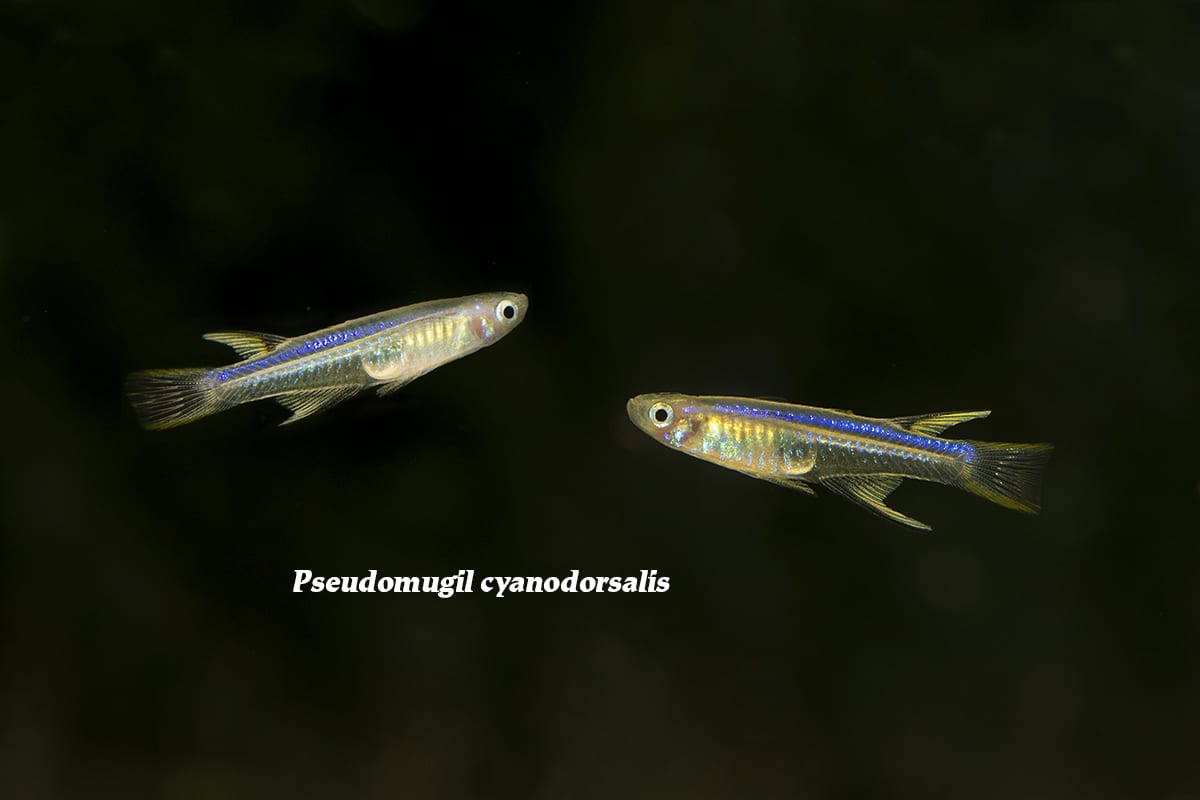Rainbowfish Connection
Rainbowfish Connection
Reflection, refraction, and dispersion. These principles as they pertain to light, act as a recipe to form one of the most beloved meteorological phenomena known to man. The rainbow.. When it comes down to it, rainbows are just light, which we all reflect it in some way. Some animals are lucky enough to bounce light beams in resemblance of rainbows’ awe-inspiring spectral arcs, and we aquarists are lucky enough to observe this phenomenon in action. Here, we refer to, of course, a beautiful group of tropical fish…Rainbowfish. This week, we were saddled with the difficult task of selecting just three of our favorite rainbowfish to share, with dozens of lovely contenders. After much deliberation, we bring you Pseudomugil luminatus, Pseudomugil cyanodorsalis, and Pseudomugil tenellus.
Scientific NamePseudomugil luminatus
Common NameRed Neon Rainbowfish
Temperature / pH64 to 79°F / 6.5 to 7.5 pH
Native LocationIndonesia
Preferred DietSmall invertebrates
Illuminating riparian habitats of Indonesia, P. luminatus, loves the murky waters and submerged vegetation. Perfect specimens for well-developed and densely-planted tanks, they require high levels of oxygenation, floating plants, driftwood, and low light. Also known as “Red Neon Rainbowfish”, they reach about 1.4 inches in length, and exhibit bright orangey-red coloration with a light blue stripe down their back and blue rings around their eyes. As with all Pseudomugil Rainbowfish, males tend to show more vibrant coloration, and extended fins to woo their female counterparts. These fish are egg scatterers with no parental care, and are liable to consume their own eggs or fry if left to their own devices. Schooling by nature, they should be kept in conspecific groups of at least 8 to encourage their most boisterous personalities to shine, in addition to enhancing the overall visual effect of the group. Though they are peaceful, they are easily outcompeted by other species, and should not be kept in most community tanks. They fare well in single species tanks with Caridina Shrimp, or fish of similar size and temperament. In the wild, Red Neon Rainbowfish eat zooplankton, phytoplankton, and invertebrates. In captivity they fare best with diets composed of mostly live offerings with supplemental amounts of high-quality, small, floating dried-foods. Tank waters should be maintained with temperatures between 64 and 79°F, pH of 6.5 to 7.5, and hardness of 36 to 215 ppm.
Scientific NamePseudomugil cyanodorsalis
Common NameNeon Blue Eye Rainbowfish
Temperature / pH70 to 88°F / 7.0 to 8.5 pH
Native LocationAustralia/New Guinea
Preferred DietSmall invertebrates
Residents of Crab Creek and other regions of Western Australia, and Southern New Guinea, P. cyanodorsalis is a unique species capable of tolerating fluctuating water salinity levels. Inhabiting mostly coastal mangrove creeks and swamps, their habitats are influenced by daily tides or seasonal flooding. Wherever they are found, however, they tend to thrive in large populations and aggregations. In captivity, they seem to fare best in brackish conditions with lots of plant life, driftwood, and mangrove branches. Reaching up to 1.5 inches in length, these “Neon Blue Eye Rainbowfish” are glittering neon blue in coloration with black-striped fins and a nearly glowing ventral region. These Rainbowfish are most beautiful and happy when kept in groups of 10 or more in single species tanks. Pseudomugils tend to be quite timid, and are easily outcompeted or goaded into hiding for long periods of time when kept alongside larger species. With similar eating habits to “Red Neons”, they can be fed following the same guidelines. Optimal water conditions include temperatures of 70 to 88°F, pH between 7.0 and 8.5, and hardness of 179 to 447 ppm.
Scientific NamePseudomugil tenellus
Common NameDelicate Blue Eye Rainbowfish
Temperature / pH77 to 89°F / 5.5 to 7.5 pH
Native LocationAustralia
Preferred DietSmall invertebrates
Another set of blue eyes to linger on, P. tenellus, is found in the East Alligator River System of the Northern Territory of Australia. Inhabiting coastal floodplains, these “Delicate Blue Eye Rainbowfish” are not so delicate since they too are able to tolerate varying salinity. This species thrives in densely-planted tanks with floating plants, driftwood roots and branches, diffuse lighting, high oxygenation, and some water flow. Reaching just over 2 inches in length, these Rainbowfish exhibit shimmering silver bodies with golden-flecked chests, feathered fins, and bright blue eyes. Following the example of our last Rainbows, these are schooling by nature, and should be kept in groups of 8 or more conspecifics. Suitable for well chosen community tanks, they can be kept alongside species of similar size and dispositions like cyprinids or gobiids. Opportunistic omnivores by nature, they feed primarily on floating zooplankton, phytoplankton, algae, and invertebrates. In captivity they can be fed small live meals, and high quality crushed dried foods with some vegetal or algal composition. Tank waters should be maintained with temperatures between 77 and 89°F, pH of 5.5 to 7.5, and hardness between 90 and 357 ppm.
Humans have been chasing rainbows for millennia whether for the mythic pot of gold, or to simply recreate and infuse their lives with some extra color. Here at The Wet Spot we’ve got the treasure you seek.


